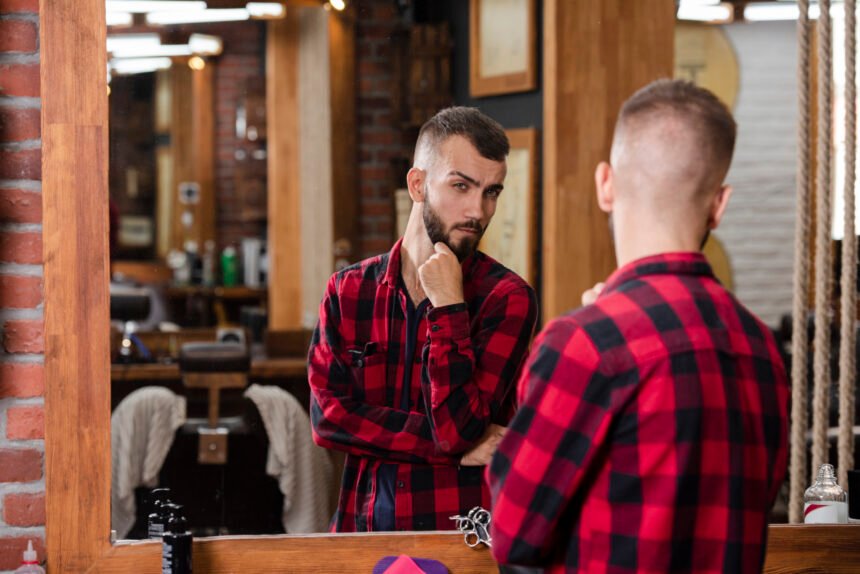A low taper textured fringe is a stylish, modern haircut that mixes clean sides with a soft, messy fringe on top. It is one of the most popular hairstyles for teens, young adults, and anyone who wants a trendy look that is not too hard to manage. However, many people struggle to explain this haircut to their barber. Sometimes the barber cuts the fringe too short. Sometimes the taper is too high. Sometimes the hair on top gets thinned out too much. That’s why knowing how to clearly tell your barber exactly what you want is very important. With the right words, examples, and guidance, you can walk into the barbershop and walk out with the perfect version of this haircut every time.
In this guide, you will learn exactly how to describe the style, what details to mention, what photo to bring, and what steps your barber will follow. You will also learn how to avoid mistakes, how to check the haircut during the process, and how to choose the right taper height, fringe length, and texture for your face shape and hair type. This article will make your next barbershop visit simple and stress-free.
Why Communication With Your Barber Matters
Barbers understand many hairstyles, but every person has a different taste, hair type, and face shape. If you don’t explain your haircut clearly, your barber might cut something you didn’t expect.
Good communication helps you:
- Get the exact haircut you want
- Avoid mistakes
- Match the cut to your face shape
- Match the cut to your hair type
- Make sure the taper is low (not mid or high)
- Get the right fringe length
- Avoid losing too much hair on top
Even a great barber cannot guess what you want unless you explain it.
Step 1: Know Your Hair Type Before You Ask
Your hair type affects how the textured fringe will look.
Straight Hair
- Easy to style
- Fringe looks choppy
- Needs product for texture
Wavy Hair
- Best for this haircut
- Natural messy look
- Needs little styling
Curly Hair
- Heavy texture
- Soft front curls
- Taper helps control volume
Coily Hair
- Strong texture
- Works well with twist-out
- Needs moisture
Tell your barber your hair type so they can adjust the cut.
Step 2: Bring Photos (VERY IMPORTANT)
Most people explain styles differently.
But photos remove all confusion.
Always bring:
- A front-view photo
- A side-view photo
- A back view photo
Why photos help:
- Barber sees the exact taper height
- Barber sees a fringe shape
- Barber sees the top length
- Barber sees the texture you want
Barbers LOVE photos because they make the job easy.
Step 3: Use Clear Words Your Barber Understands
Barbers use specific terms.
If you use the right words, you will always get the right haircut.
Key words to say:
✔ “I want a low taper.”
This means:
- The fade starts low
- Near the ears and neckline
- Not a mid fade
- Not a high fade
✔ “Please keep the taper soft.”
This means:
- Not too sharp
- Not too bald
- Smooth blend
✔ “I want a textured fringe in the front.”
This means:
- Messy
- Choppy
- Not straight
- Not blunt
✔ “Please leave the top long enough for texture.”
This means:
- Barber will not cut too short
- More volume and movement
Using these words helps your barber understand exactly what style you want.
Step 4: Explain the Fringe Shape You Want
The fringe is the most important part.
If the fringe is wrong, the whole look changes.
Choose your fringe style:
1. Light Messy Fringe
- Soft
- Airy
- Best for everyday looks
2. Medium Textured Fringe
- Most popular
- Balanced length
- Nice movement
3. Longer Heavy Fringe
- Covers more forehead
- Works well with waves or curls
Say this to your barber:
“Please keep the fringe long enough to style and add texture. Do not cut it too short.”
This sentence alone prevents the most common barber mistake.
Step 5: Tell the Barber How Short (or Long) to Cut the Top
The top controls the fullness of the hairstyle.
Best top lengths for this style:
- 2 to 3 inches for straight hair
- 3 to 4 inches for wavy hair
- 4+ inches for curly hair
Tell your barber:
“Please keep the top long enough so I can add texture with my fingers.”
This keeps the haircut modern and stylish.
Step 6: Explain How You Style at Home
Your barber needs to know how much time you spend on styling.
If you want low maintenance:
- Choose shorter fringe
- Choose soft taper
- Choose simple layers
If you don’t mind styling:
- Choose longer fringe
- Choose heavier texture
- Choose layered top
If your hair grows fast:
- Ask for a lighter taper
- Ask for a softer blend
- Helps the haircut last longer
Talk to your barber about your routine.
Step 7: Confirm the Taper Height Before Cutting
This is very important.
Many barbers cut the taper TOO HIGH unless you explain it clearly.
Say this:
“Please keep the taper low. Start the fade near the ear, not higher.”
Low taper means:
- Bottom of the hair
- Near the ear
- Soft blend upward
- Not too sharp
- Clean neckline
Always confirm this before your barber starts.
Step 8: Check the Cut During the Process
You don’t have to wait until the end to see mistakes.
Check during the haircut.
3 moments to check:
- After the taper is done
- After the top is trimmed
- Before the fringe is cut
What to look for:
- Is the taper low enough?
- Is the top still long?
- Is the fringe shape correct?
Never be afraid to ask the barber to adjust.
Step 9: Ask for Texture
Texture makes the haircut look modern.
You can ask for:
- Choppy texture
- Point-cutting
- Scissor-over-comb
- Razor texture
Say this to your barber:
“Please add some texture to the fringe and top. I want a soft, messy look.”
This gives the hairstyle movement and shape.
Step 10: Tell Your Barber How You Want the Neckline
Necklines change the final shape.
Options:
- Tapered neckline (best)
- Natural neckline
- Rounded neckline
- Slight box shape
Best choice for this style:
✔ Tapered neckline
It blends smoothly with the low taper.
How to Talk About Your Face Shape With Your Barber
Different face shapes need different fringe lengths.
Oval Face
- Any fringe works
- Best with medium texture
Round Face
- Longer fringe
- More angles
- Sharper taper
Square Face
- Soft fringe
- Light movement
Long Face
- Lower volume
- Full fringe
- Soft top
Share your face shape so your barber can adjust.
How to Avoid the Most Common Barber Mistakes
You can save yourself from a bad haircut by knowing these mistakes.
Mistake 1: Taper too high
Solution:
“Please keep the taper low only around the ears.”
Mistake 2: Fringe cut too short
Solution:
“Please leave the fringe long enough for texture.”
Mistake 3: The Top cut is too flat
Solution:
“Please keep the top layer, not flat.”
Mistake 4: Too much thinning
Solution:
“Please do not thin out the top too much.”
Speak up early to avoid issues.
What to Do After the Haircut
A fresh cut is good, but you also need to maintain it.
Daily
- Style with cream or clay
- Shape fringe with fingers
Weekly
- Clean neck hair
- Shape tapers slightly
Monthly
- Barber trim
- Refresh texture
- Shape fringe again
Doing this keeps your haircut sharp.
Best Phrases to Use at the Barber
Here are the exact words:
✔ “I want a low taper, not a mid or high fade.”
✔ “Keep the fringe long and textured.”
✔ “Please leave the top long enough to style.”
✔ “Add texture to the front and top.”
✔ “Blend the taper softly.”
✔ “Do not remove too much weight from the top.”
Use these sentences exactly when you speak to your barber.
Conclusion
Asking your barber for a low taper textured fringe becomes simple once you know the right words and explain the details clearly. Bringing photos, describing the fringe length, setting the taper height, and talking about your styling routine help your barber understand exactly what you want. With the right guidance, your barber can shape the taper, add texture, and cut the fringe in a way that fits your face shape and hair type. And if you want to learn more about similar hairstyles or compare this cut with others like the Low Fade Haircut, feel free to explore our site for more ideas and grooming tips.














